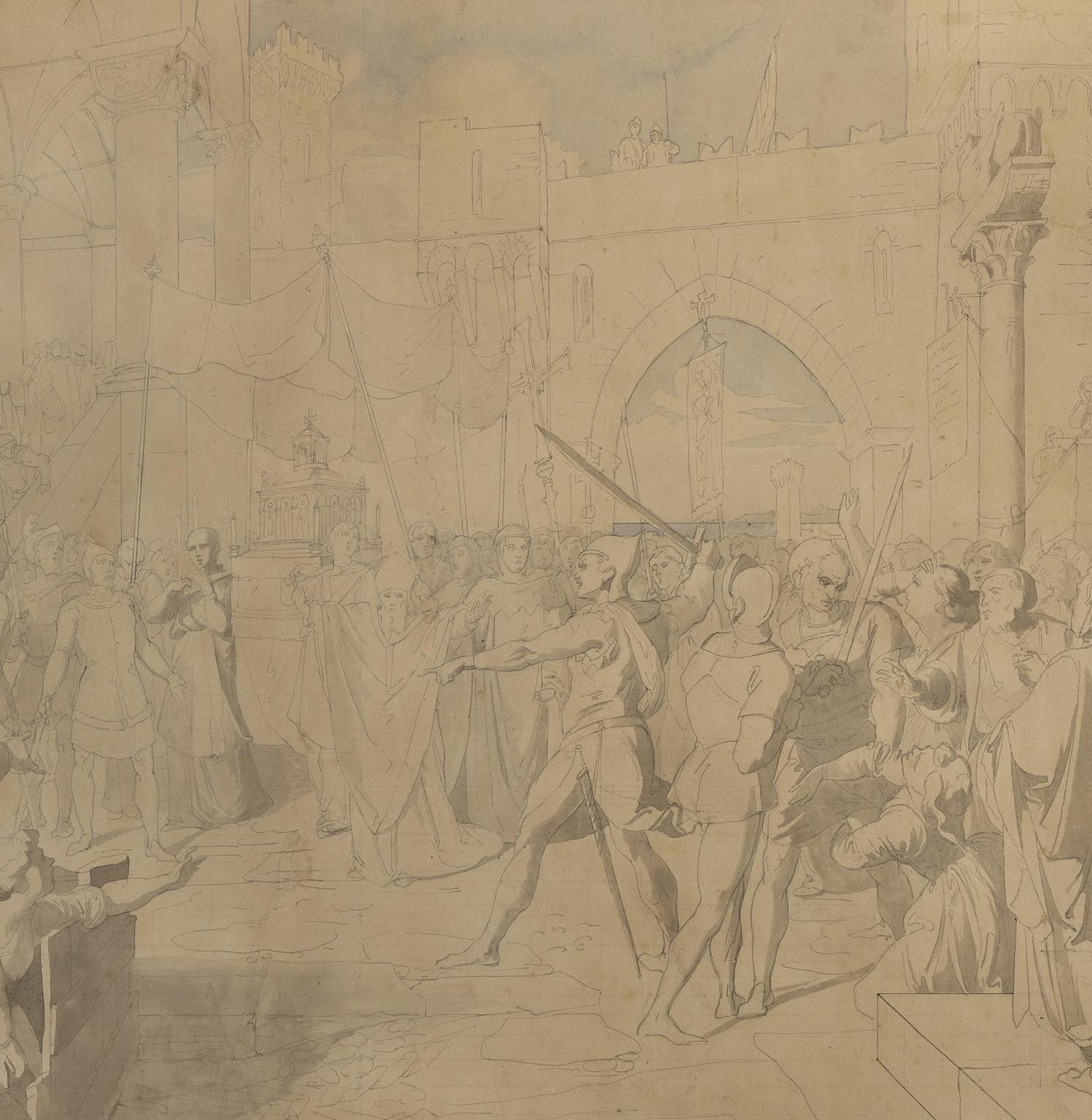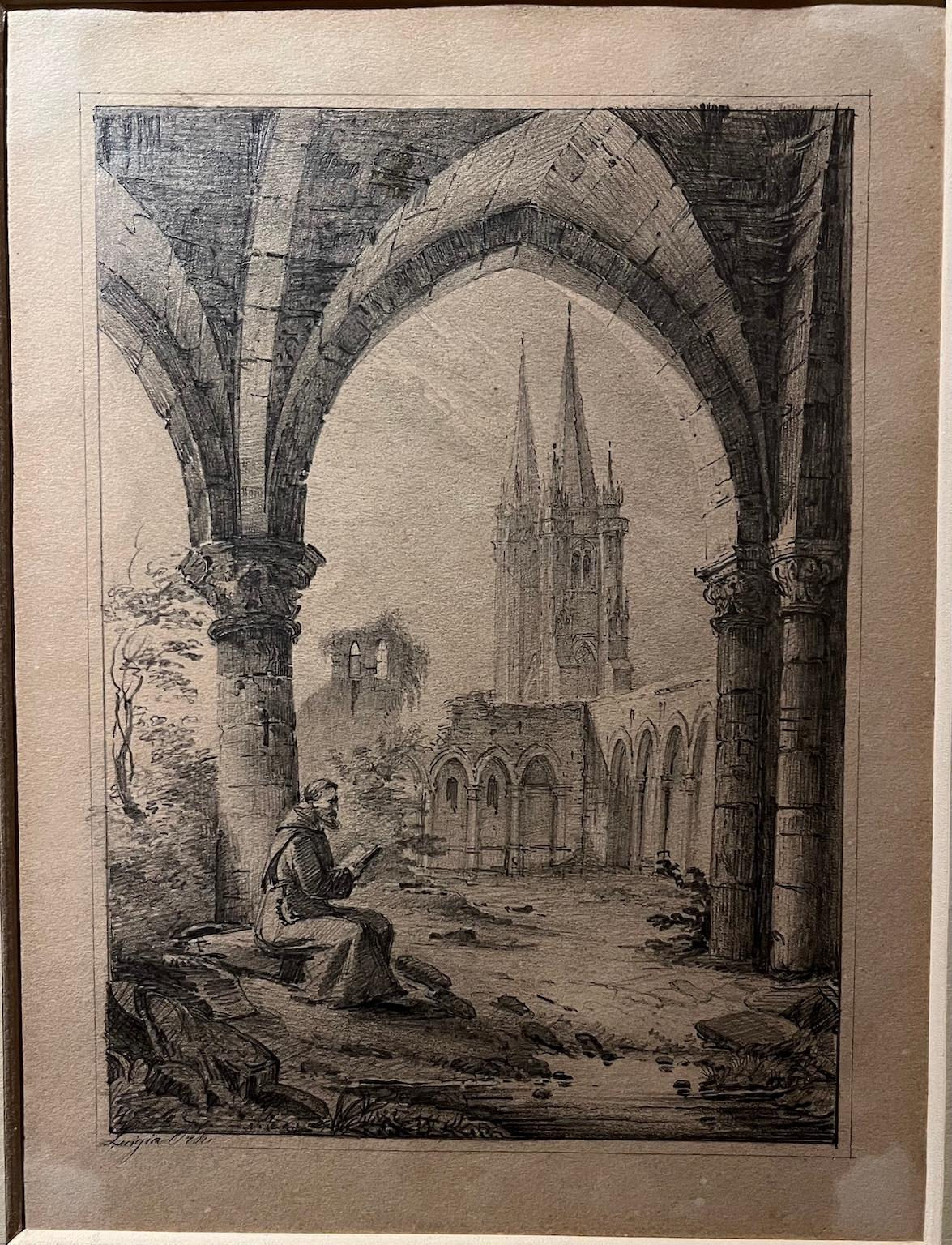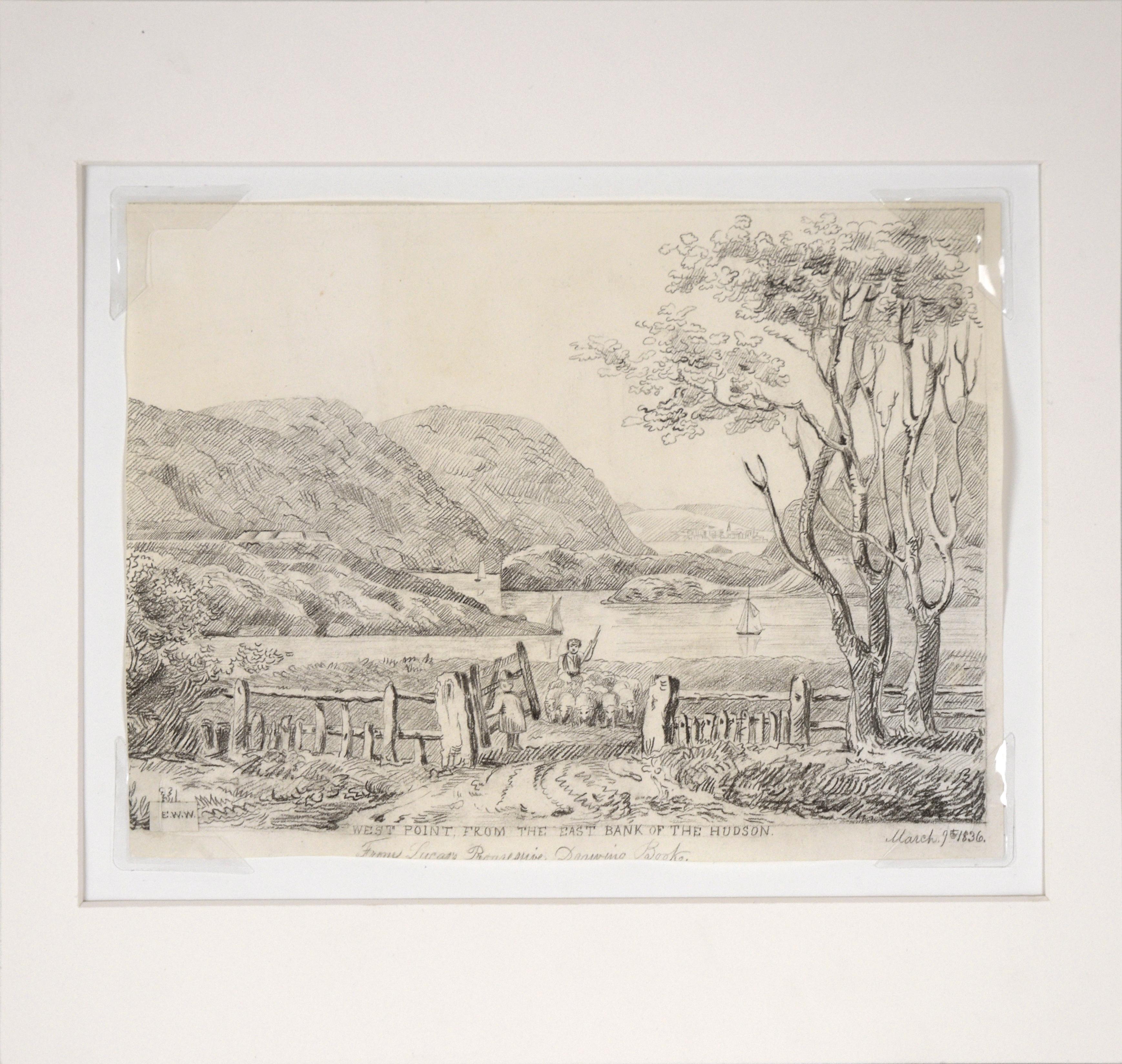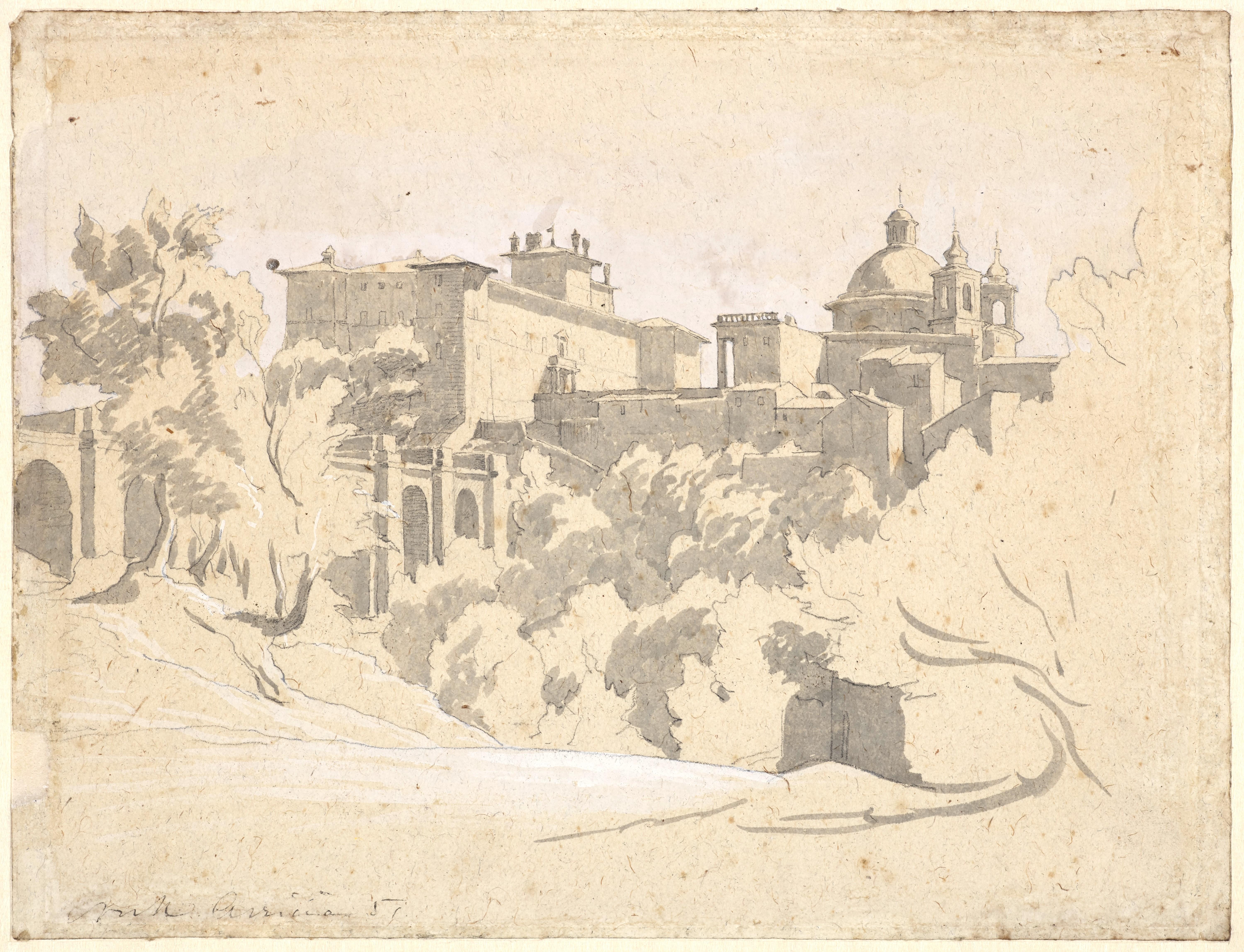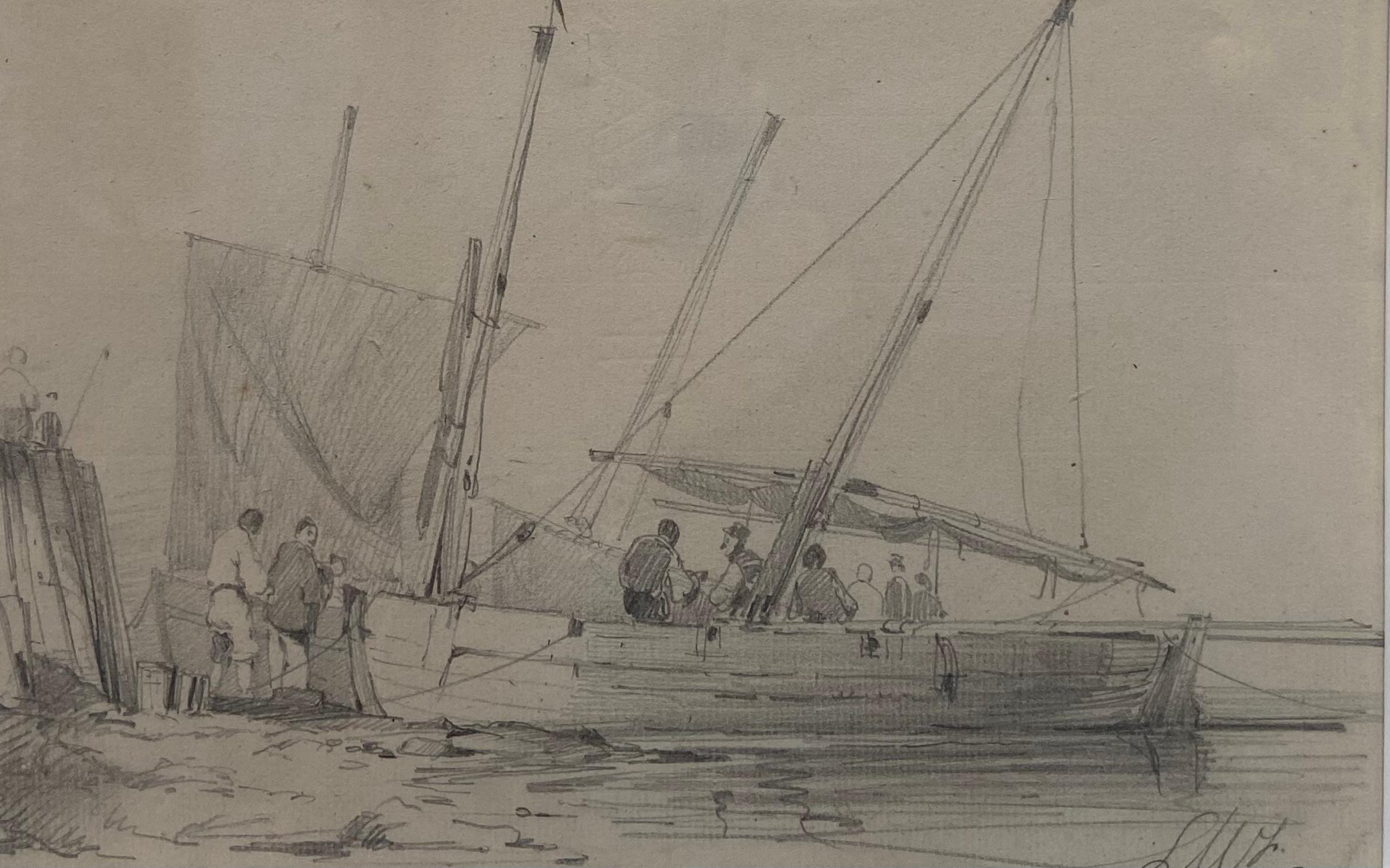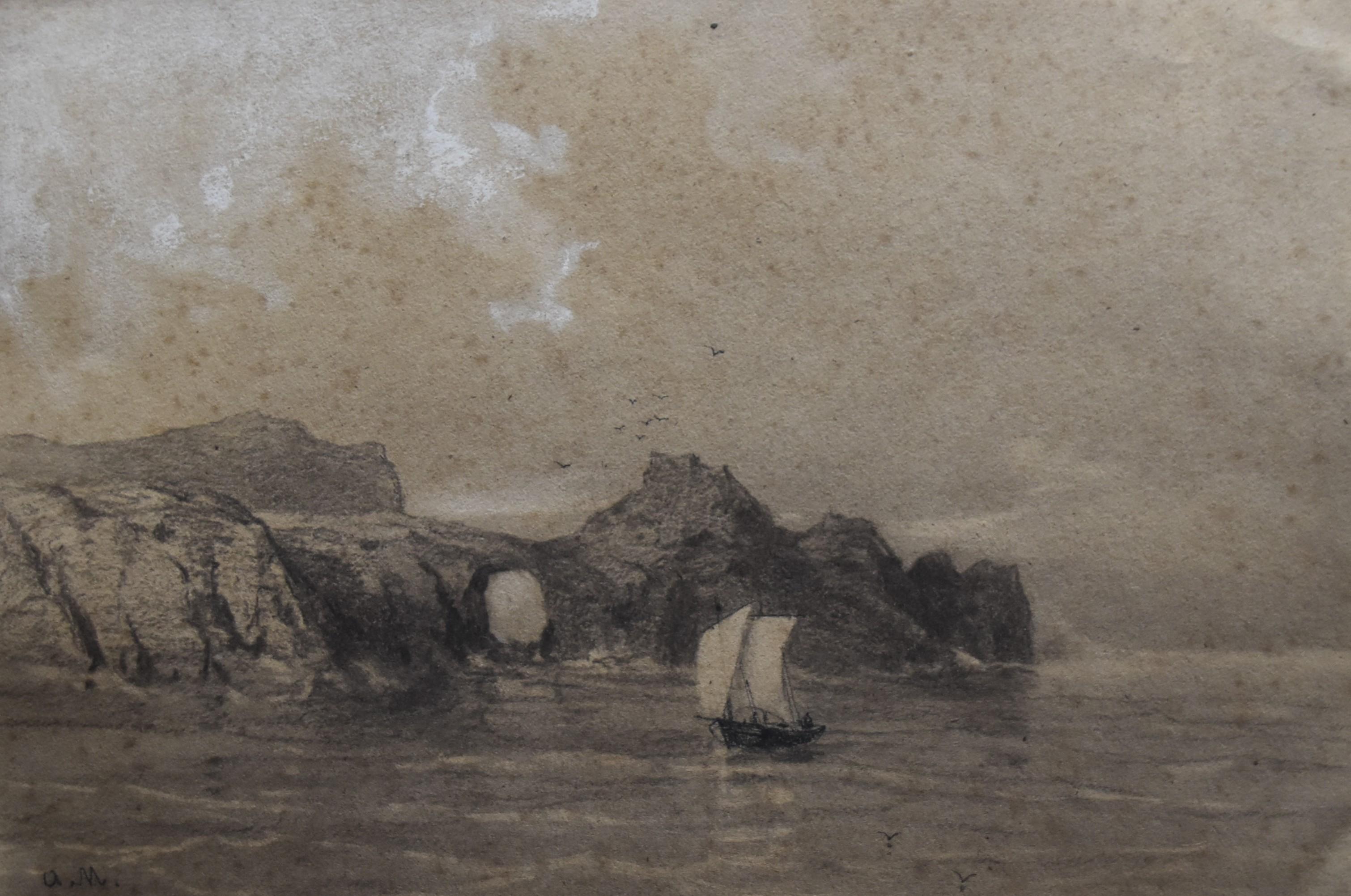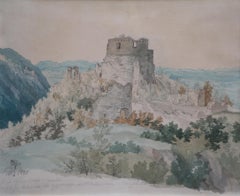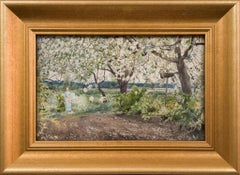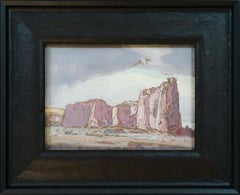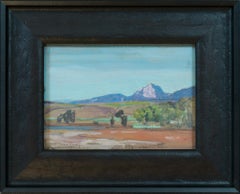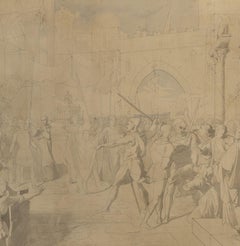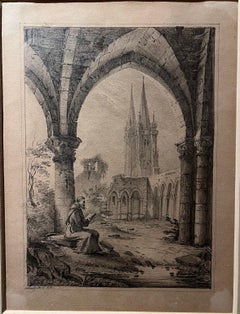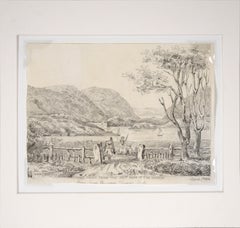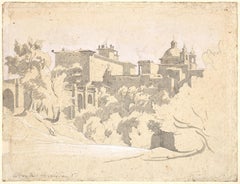Articoli simili a Evening Calm by the Northern River
Vuoi altre immagini o video?
Richiedi altre immagini o video al venditore
1 di 9
Oscar LyckeEvening Calm by the Northern Riverc. 1910
c. 1910
Informazioni sull’articolo
ink on paper
signed OSC. LYCKE
unframed 24 x 34 cm (9.4 x 13.4 in)
framed 33.5 x 43.5 cm (13.2 x 17.1 in)
Provenance:
Acquired directly from Katarina Gunnarsson, who inherited the painting from her mother, Barbro, the daughter of the artist.
Essay:
This ink landscape by Oscar Lycke (c. 1910) evokes the tranquil beauty of a remote northern valley. Bold black lines sweep across the paper to define a still river winding between gently rolling hills. In the foreground a humble log cabin nestles at the water’s edge, framed by slender birch and fir trees. Above, the sky is hinted at with strokes and washes of ink, suggesting a soft, diffused light. Although rendered simply, the scene feels remarkably three‑dimensional: darkly inked foreground shapes push forward against lighter, more delicate strokes in the distance. The effect is one of quiet serenity – the kind of calm encounter with nature that Lycke loved to capture. Lycke often painted and drew the Indalsälven valley in northern Sweden, especially around the village of Liden, and this image likely reflects that region. The gently undulating ridges and the placid river here closely resemble the Liden landscape he returned to again and again. One can almost imagine the shadowy woods and glassy water of Bodacke in Liden at dusk. This setting – an unspoiled Nordic river valley – was a recurring motif in Lycke’s work. He was deeply attached to the Swedish north; his art consistently celebrates its expansive forests, mirrored lakes, and rustic farmsteads.
Technique and Style
Lycke’s mastery of ink is evident in every expressive stroke. Using only black ink on paper, he achieves a rich range of tone and texture. Thick, confident strokes suggest the solidity of the cabin walls and tree trunks, while thinner, more rapid lines imply the finer details of foliage and rippling water. Some areas are left nearly blank – washes of pale ink indicate sky and distant hills – creating bright highlights that contrast with the deep blacks. The result is a dynamic interplay of light and shadow. Lycke applies the ink with a kind of lyrical energy: lines sometimes curl and dance, giving life to the scene, yet everywhere they remain under control, defining form with precision. This balance of spontaneity and discipline reflects his self-taught background. Without formal academic training, Lycke developed a personal technique that feels at once free and deliberate. The drawing’s expressive lines and compositional skill speak to his innate draftsmanship. Even in monochrome, he captures the “Nordic light” – the cool glow of a long summer evening – using subtle gradations of gray and sharp silhouettes against the sky. The overall effect is both bold and atmospheric, demonstrating Lycke’s confidence in handling ink as his medium.
Education and International Success
Lycke’s artistic journey was unconventional. Born in Sundsvall in 1877, he never attended a formal art academy. A childhood gift for drawing grew into a lifelong passion, and as a young man he moved to Stockholm to try making art his livelihood. He spent those early years studying nature directly and producing illustrations for magazines – a practical way to hone his skill. Around the turn of the century he even traveled to North America on art-study trips, broadening his perspective far from Sweden. Despite humble beginnings (and one discouraging schoolmaster), Lycke persevered. Over time he exhibited widely across Sweden – from Gothenburg to the north – and gradually gained recognition. His most remarkable success came abroad. In the 1910s Lycke brought his northern landscapes to New York, and American audiences were captivated. Contemporary accounts report that his exhibition in New York was a sensation: every painting he showed there sold quickly. The clear, romantic portrayal of Swedish wilderness and the masterful technique behind each canvas and drawing resonated with collectors and critics. In this way, Lycke achieved international acclaim, even while remaining relatively humble at home. By the time of his later shows – in Stockholm and back in Sundsvall – he was celebrated as a leading interpreter of Sweden’s natural beauty. Throughout his career, Lycke’s work remained rooted in the Swedish countryside. He captured all seasons of the north – from snowy winter nights to the midnight sun of summer – but always with the same reverence for nature. In Evening Calm by the Northern River, we see that devotion distilled into a simple ink study.
- Creatore:Oscar Lycke (1877 - 1927, Svedese)
- Anno di creazione:c. 1910
- Dimensioni:Altezza: 24 cm (9,45 in)Larghezza: 34 cm (13,39 in)
- Tecnica:
- Movimento e stile:
- Periodo:
- Condizioni:Very good condition. age related patina. A new black frame with UV protected art glass is included.
- Località della galleria:Stockholm, SE
- Numero di riferimento:1stDibs: LU1445216379802
Oscar Lycke era un pittore svedese noto soprattutto per le sue evocative rappresentazioni del paesaggio nordico. Nato a Sundsvall nel 1877, ha dedicato la sua vita a catturare le foreste, i fiumi e la luce del Norrland in opere che combinano il romanticismo nazionale con un forte senso del realismo. I suoi dipinti sono amati ancora oggi per la loro atmosfera vivida e per il loro legame con l'ambiente nordico. In gran parte autodidatta, Lycke dimostrò talento artistico fin dalla tenera età. Dopo aver ricevuto incoraggiamenti contrastanti dai suoi insegnanti, all'età di 20 anni lasciò Sundsvall per intraprendere una carriera artistica a Stoccolma. I primi anni sono stati difficili - non aveva una formazione formale e faticava a guadagnarsi da vivere - ma la sua dedizione non ha mai vacillato. Con il passare del tempo si è fatto conoscere e ha iniziato a esporre in città svedesi, tra cui Malmö e Norrköping, oltre che a livello internazionale a Copenaghen e New York. Lycke era costantemente in movimento, viaggiando attraverso la Svezia alla ricerca di nuovi paesaggi e di ispirazione. Visse in diversi periodi in luoghi come Delsbo e Hudiksvall e, durante gli anni della guerra del 1915-1918, si stabilì a Stoccolma, trascorrendo le estati con la sua famiglia a Räfsnäs, nell'arcipelago di Stoccolma. Alla fine tornò nella sua città natale, Sundsvall, dove continuò a dipingere fino alla fine della sua vita. Il suo stile artistico riflette l'atmosfera culturale dell'arte svedese del primo Novecento. Come molti dei suoi contemporanei, Lycke era attratto dai temi nazionali, trovando bellezza e identità nella campagna svedese. I suoi paesaggi ritraggono spesso la luce mutevole dell'alba o del tramonto, fitte foreste di abeti rossi e sentieri tranquilli che risplendono di colori naturali. La risonanza emotiva del suo lavoro, radicata sia nella memoria che nel luogo, lo ha reso uno dei preferiti soprattutto tra coloro che hanno legami con il nord. Oscar Lycke morì nel 1927 all'età di 50 anni, dopo un lungo periodo di malattia e di declino della vista. Una mostra commemorativa al museo Sundsvalls alla fine degli anni '70 ha riaffermato la sua importanza, soprattutto come pittore della Svezia settentrionale. Oggi Oscar Lycke rimane una figura molto apprezzata dell'arte svedese del primo Novecento, ricordato per le sue liriche rappresentazioni dei paesaggi del Norrland e per la sua capacità di trasformare la natura quotidiana in qualcosa di senza tempo.
Informazioni sul venditore
5,0
Venditore Platino
Venditori Premium con valutazione 4.7+ e tempi di risposta entro 24 ore
Fondazione nel 2020
Venditore 1stDibs dal 2020
179 vendite su 1stDibs
Tempo di risposta standard: <1 ora
Associazioni
International Confederation of Art and Antique Dealers' Associations
- SpedizioneRecupero del preventivo…Spedizione da: Stockholm, Svezia
- Politica di reso
Alcune parti di questa pagina sono state tradotte automaticamente. 1stDibs non può garantire che le traduzioni siano corrette. L’inglese è la lingua predefinita del sito.
Garanzia di autenticità
Nell’improbabile caso in cui si verifichi un problema con l’autenticità di un articolo, contattaci entro un anno per ottenere un rimborso completo. DettagliGaranzia di rimborso
Se il tuo articolo non corrisponde alla descrizione, è danneggiato durante il trasporto o non arriva, contattaci entro 7 giorni per un rimborso completo. DettagliAnnullamento entro 24 ore
Hai un periodo di tolleranza di 24 ore per annullare il tuo acquisto, senza necessità di fornire spiegazioni.Venditori professionali selezionati
I nostri venditori di livello internazionale devono aderire a rigorosi standard di servizio e qualità, garantendo l’integrità delle inserzioni.Garanzia miglior prezzo
Se scopri che un venditore ha pubblicato altrove lo stesso articolo a un prezzo più basso, applicheremo lo stesso prezzo.Consegna globale affidabile
La nostra rete di vettori leader del settore offre opzioni di spedizione specializzate in tutto il mondo, inclusa la consegna personalizzata.Altro da questo venditore
Mostra tuttoLe rovine del castello imperiale fuori Spalato in Croazia
Gustaf Wilhelm Palm (1810-1890) Svezia
Le rovine del castello imperiale fuori Spalato in Croazia
matita e acquerello
senza cornice: 23,6 x 29,2 cm (9 1/4 x 11 1/2 in)
incorniciato...
Categoria
Anni 1840, Romantico, Disegni e acquarelli (paesaggio)
Materiali
Carta, Acquarello
Acquerello Il giardino di Sickelsjö, 1883
Siamo lieti di presentare uno splendido acquerello dell'artista svedese Albert Theodor Gellerstedt. Quest'opera, intitolata "Sickelsjö Trädgård", è stata creata l'8 giugno 1883. Il d...
Categoria
Anni 1880, Romantico, Disegni e acquarelli (paesaggio)
Materiali
Carta, Acquarello
Inscription Rock, New Mexico - Luce del Sud-Ovest in guazzo di Carl Oscar Borg
Di Carl Oscar Borg
Carl Oscar Borg (1879-1947) svedese/americano
Roccia dell'iscrizione, Nuovo Messico
gouache su cartoncino
firmato CARL OSCAR Borg.
senza cornice: 12 x 17,5 cm (4 3/4 x 6 7/8 in)
in...
Categoria
Inizio XX secolo, Romantico, Disegni e acquarelli (paesaggio)
Materiali
Gouache
Montagne Blu, New Mexico
Di Carl Oscar Borg
In questo luminoso studio paesaggistico, Carl Oscar Borg cattura la serena bellezza dell'alto deserto del Nuovo Messico, guardando probabilmente verso il Monte Taylor, un picco sacro...
Categoria
Inizio XX secolo, Romantico, Disegni e acquarelli (paesaggio)
Materiali
Gouache
Paesaggio dell'Arizona - Cieli drammatici e luce del deserto di Carl Oscar Borg
Di Carl Oscar Borg
In questo espressivo studio a guazzo, Carl Oscar Borg cattura la drammaticità degli altopiani dell'Arizona, dove le nuvole temporalesche si addensano su mesas stratificate e valli im...
Categoria
Inizio XX secolo, Romantico, Disegni e acquarelli (paesaggio)
Materiali
Gouache
Paesaggio rurale con mucche e cavalli, acquerello di Hilding Linnqvist
Questo acquerello è opera di Hilding Linnqvist, artista svedese nata nel 1891 e scomparsa nel 1984.
Linnqvist, noto per la sua associazione con il movimento Naïvist, spesso descritto...
Categoria
Inizio XX secolo, Romantico, Disegni e acquarelli (animali)
Materiali
Acquarello
2.226 USD Prezzo promozionale
20% in meno
Ti potrebbe interessare anche
Disegno figurativo storico del romanticismo italiano del XIX secolo
Il soggetto qui illustrato è uno dei momenti che segnano la secolare storia della gloriosa Repubblica marinara di Genova, quando entrano in città le ceneri di San Giovanni Battista, ...
Categoria
1860s, Romantico, Disegni e acquarelli figurativi
Materiali
Carta, Acquarello, Penna, Matita
Disegno figurativo religioso italiano gotico del XIX secolo matita su carta
Questo piccolo disegno (matita su carta, 25 x 19,5 cm) raffigura un frate (che dallo stile della tonsura e della tunica sembrerebbe essere un francescano) sulla sinistra, seduto nell...
Categoria
19th Century, Romantico, Disegni e acquarelli (paesaggio)
Materiali
Carta, Matita
"West Point dalla riva orientale dell'Hudson" Disegno antico su carta Watkinson
"West Point dalla riva orientale dell'Hudson" Disegno antico su carta
Disegno delicato e dettagliato dell'artista di Hartford, Connecticut, Edward Watkins Wells (1819-1898) L'osserv...
Categoria
Anni 1830, Romantico, Disegni e acquarelli (paesaggio)
Materiali
Carta vergata, Matita
2.000 USD Prezzo promozionale
20% in meno
Veduta di Ariccia, disegno preparatorio di Achille Bénouville (1815 - 1891)
Questo disegno molto moderno presenta una veduta di Ariccia, una piccola città a 25 chilometri a sud-est di Roma. Il Palazzo Chigi (in cui il regista Luchino Visconti girerà gran par...
Categoria
Anni 1850, Romantico, Disegni e acquarelli (paesaggio)
Materiali
Inchiostro, Gouache, Matita
Scuola francese del XIX secolo, LW (?) Scena di porto, disegno firmato
Scuola francese del XIX secolo, LW (?)
Scena del porto, animazione intorno a una barca
Matita su carta Firmato LW (?) In basso a destra
15 x 21 cm
Incorniciato: 27 x 34,5 cm
Ques...
Categoria
Anni 1840, Romantico, Disegni e acquarelli (paesaggio)
Materiali
Matita carboncino
Auguste Mayer (1805-1890) Un paesaggio marino con una barca, disegno firmato
Auguste Mayer (1803-1890
Un paesaggio marino con una barca
firmato con le iniziali in basso a sinistra
Matita e sfumature di gouache bianca su carta
17,5 x 26 cm
In discrete condizio...
Categoria
Anni 1860, Romantico, Disegni e acquarelli (paesaggio)
Materiali
Gouache, Matita carboncino
352 USD Prezzo promozionale
20% in meno
